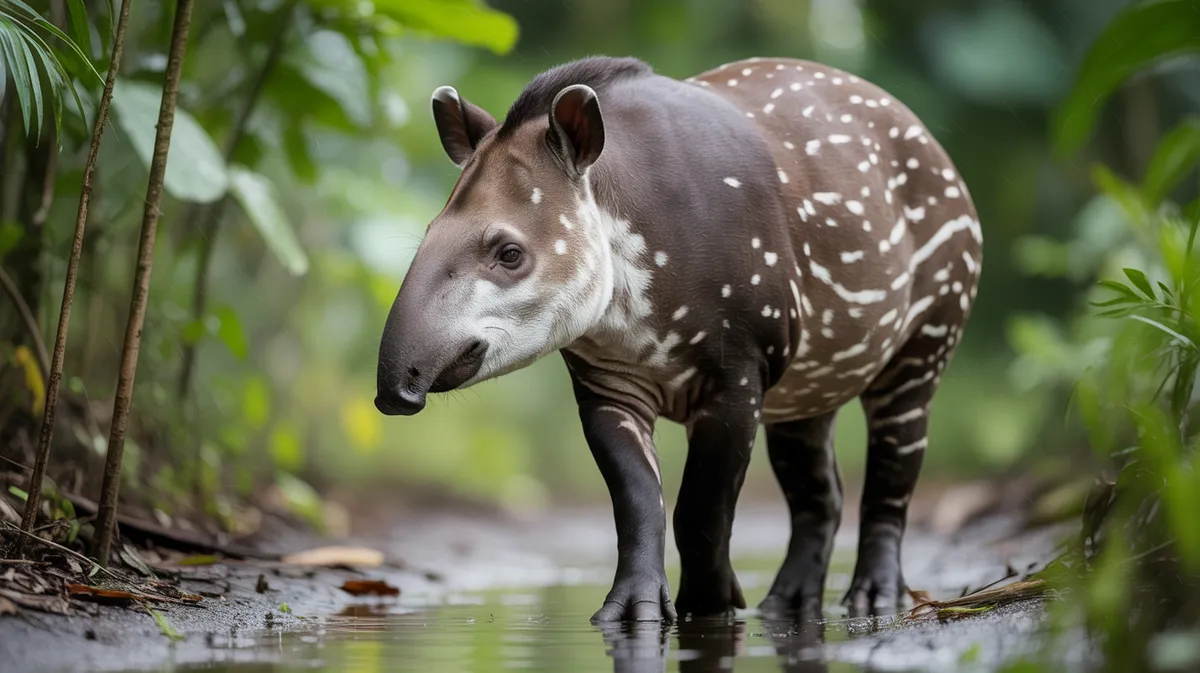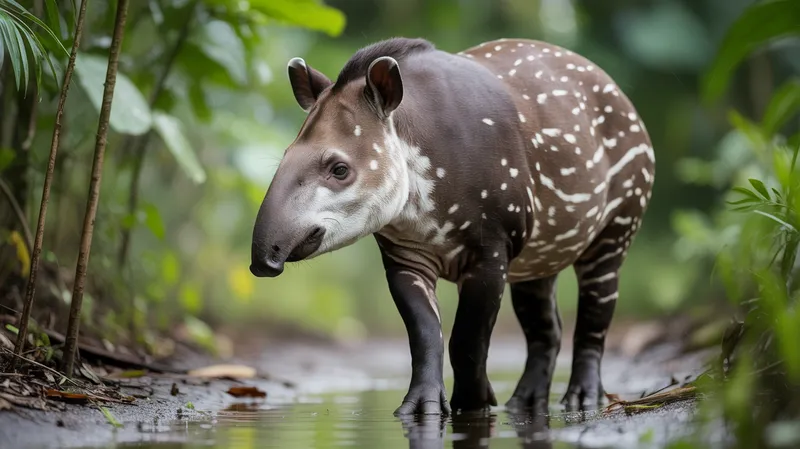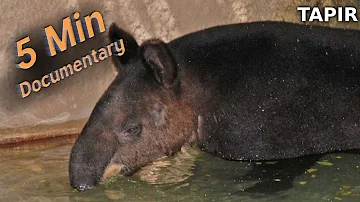
Baird's Tapir
Tapirus bairdii

Meet the Baird's Tapir
Baird's Tapir is the largest indigenous terrestrial mammal in Central America, recognized by its distinctive prehensile snout, which it uses to grab foliage and fruit. This shy, mostly nocturnal herbivore is found in dense forests and swamps from southern Mexico through Central America to northwestern Colombia. Its thick, dark brown fur is complemented by a pale cream-colored patch on its face and throat. Baird's Tapir plays a crucial ecological role as a seed disperser, helping sustain the health and diversity of tropical forests.
Classification
Mammal
Habitat
Tropical forests, swamps, and lowland rainforests
Diet
Herbivore
Lifespan
25-30 years
Conservation
Endangered
Weight
150-400 kg
📖Fascinating Facts
Ancient Lineage
Tapirs are considered living fossils, with their basic body shape unchanged for tens of millions of years.
Forest Gardener
Baird's Tapir helps maintain forest biodiversity by dispersing seeds through its droppings.
Nocturnal Wanderer
They are primarily active at night, moving silently through dense undergrowth in search of food.
📋Detailed Description
Baird's Tapir (Tapirus bairdii) is a robust, large-bodied perissodactyl, measuring 180–250 cm in length and standing 75–120 cm at the shoulder, with adults weighing between 150 and 400 kg. Its most distinctive feature is a flexible, prehensile proboscis formed by the upper lip and nose, which is highly mobile and aids in grasping leaves and fruit. The species has a thick, tough hide, dark brown to blackish in color, with a characteristic pale cream patch running from the cheeks to the throat and often around the tips of the ears. The limbs are sturdy, with four toes on the front feet and three on the hind, well-adapted for traversing muddy or swampy terrain. Baird's tapirs are primarily solitary and crepuscular to nocturnal, relying on dense forest cover for protection. Their eyes are small and vision is limited, but they possess acute hearing and an excellent sense of smell. The species is an important ecological engineer, dispersing seeds over large distances and creating pathways through dense undergrowth. Juveniles are born with striking white and brown stripes and spots, providing camouflage, which fade as they mature. Lifespan in the wild is estimated at 25–30 years, though data are limited due to their elusive nature.
💡 Did you know?
Baird's Tapir is sometimes called the 'mountain cow' by locals, yet it is more closely related to horses and rhinoceroses than to cows.
🔬Research & Sources
Wikipedia Summary
The Baird's tapir, also known as the Central American tapir, is a species of tapir native to Mexico, Central America, and northwestern South America. It is the largest of the three species of tapir native to the Americas, as well as the largest native land mammal in both Central and South America.
Last Modified: 5/25/2025
🎭Behavior & Social Structure
Baird's tapirs are largely solitary, with individuals maintaining overlapping home ranges of 1–5 km², depending on habitat quality. They are most active during twilight and nighttime hours, foraging for a diverse array of leaves, twigs, fruits, and aquatic vegetation, and have been recorded consuming over 100 plant species. Tapirs use established trails to move between feeding and resting sites, often along riverbanks or through dense undergrowth. They are excellent swimmers and frequently enter water bodies to feed, cool off, or evade predators. Communication is primarily through high-pitched whistles, squeals, and occasional foot stamping; olfactory marking via urine and feces is also common. While generally non-aggressive, adults may defend themselves vigorously if threatened, using their powerful jaws and sharp teeth. Social interactions are limited, mainly occurring during the breeding season or between mothers and their offspring.
👶Reproduction & Life Cycle
Baird's tapirs are polygynous, with males seeking out receptive females during the breeding season, which may peak during the rainy months (April–June) but can occur year-round. Courtship involves vocalizations, scent marking, and mutual nuzzling. After mating, females undergo a gestation period of approximately 390–400 days (about 13 months), typically giving birth to a single calf weighing 6–10 kg. Twins are extremely rare. The calf is precocial, able to stand and follow its mother within hours, and is nursed for 6–8 months. Juvenile tapirs retain their cryptic striped and spotted coat for 6–8 months, providing camouflage from predators. Sexual maturity is reached at 2–4 years. Maternal care is intensive, with mothers fiercely protective of their young, and calves remain with their mothers for up to a year before becoming independent.
🛡️Adaptations & Survival
Baird's tapir exhibits several key adaptations for survival in dense, humid forests. The prehensile snout is a highly specialized adaptation for selective browsing, allowing the animal to grasp and manipulate a variety of vegetation. Its splayed toes and robust limbs facilitate movement through muddy, waterlogged environments, while the thick skin provides protection from thorny vegetation and predator bites. The cryptic coloration of juveniles aids in predator avoidance, and adults' subdued coloring helps them blend into shadowy forest interiors. Tapirs are strong swimmers, able to cross rivers and even submerge for short periods. Their acute sense of smell compensates for poor eyesight, aiding in foraging and detecting predators. Behavioral adaptations include nocturnality and the use of established trails to minimize energy expenditure and exposure to threats.
📚Research Sources
🎨Cultural Significance
Baird's tapir holds cultural significance among several indigenous groups in Central America, often featuring in local folklore as a symbol of the forest or as a spirit animal. In some traditions, the tapir is associated with rain and fertility, and its presence is considered an indicator of healthy forests. Historically, tapirs have been hunted for their meat and hide, though this practice has declined in many areas due to legal protections. The species is also a flagship for conservation campaigns in Mesoamerica, representing broader efforts to preserve tropical forest ecosystems.
🔬Recent Research & Discoveries
Recent research has focused on the tapir's role as a keystone seed disperser, with studies demonstrating its importance in maintaining plant diversity and forest regeneration. Advances in camera trapping and GPS telemetry have improved understanding of tapir movement patterns, habitat use, and population densities. Genetic studies are underway to assess population structure and connectivity, informing conservation planning. There is growing interest in the impact of habitat fragmentation on gene flow and long-term viability. Ongoing projects in Costa Rica, Panama, and Mexico are testing community-based conservation models and wildlife corridors to enhance habitat connectivity. The species is also monitored as a bioindicator for ecosystem health in Central American forests.
🎥Wildlife Videos

🐾 The Baird's Tapir – The Forest Giant with a Trunk! 🌳🔥
The Baird's Tapir – The Forest Giant with a Trunk! Meet the Baird's Tapir, one of the largest land mammals in Central America ...
Ases World

Why Tapirs Love Spending So Much Time Underwater
Tapirs love to dive into the water, where they'll use their snout as a snorkel. There, they can evade jaguars, eat aquatic plants and ...
Smithsonian Channel

Skin & Bones - Animal Life: Baird's Tapir (new version)
Baird's Tapir was named in 1865 for the Assistant Secretary of the Smithsonian, Spencer Fullerton Baird. It's the largest mammal ...
Smithsonian's National Museum of Natural History

What in the World is a Tapir? | National Geographic
About National Geographic: National Geographic is the world's premium destination for science, exploration, and adventure.
National Geographic

Rare Baird's Tapir Sighting | Costa Rica & Panama | Lindblad Expeditions-National Geographic
A Baird's tapir greets visitors to Corcovado National Park. Because tapirs are solitary and largely nocturnal, it's unusual to spot ...
Lindblad Expeditions

Tapir - 5 Minute Documentary
Embark on a captivating journey into the lush rainforests and serene savannas with a five-minute documentary that delves into the ...
Five Minute Documentaries
🌍Habitat Information
The Baird's Tapir typically inhabits Tropical forests, swamps, and lowland rainforests environments. Baird's Tapirs have adapted to their environments with specialized features and behaviors.
Primary Habitat:
Tropical forests, swamps, and lowland rainforests
More detailed habitat information will be available soon.
🛡️Conservation Status
The Baird's Tapir is currently classified as Endangered. Conservation efforts are crucial for preserving this species for future generations.
Common Threats:
- 🏠Habitat loss and fragmentation
- 🌡️Climate change impacts
- 🎯Hunting and poaching
- 🏭Human-wildlife conflict
⚠️Threats & Conservation Challenges
Baird's tapir faces numerous threats, leading to its classification as Endangered by the IUCN. Habitat loss and fragmentation due to deforestation, agricultural expansion, and infrastructure development are the most significant challenges, severely reducing available range and isolating populations. Illegal hunting for meat and hide, as well as accidental deaths from snares and roadkill, further exacerbate declines. The species' low reproductive rate and large home range requirements make recovery difficult. Climate change may also impact habitat suitability and food availability. Current population estimates suggest fewer than 5,500 mature individuals remain, with ongoing declines and local extinctions reported in parts of its range. Conservation efforts are hampered by limited funding, insufficient enforcement of protective legislation, and lack of public awareness.
🔬Scientific Classification
Scientific Name
Tapirus bairdii
Classification Hierarchy
🔍 About Taxonomic Classification
Taxonomic classification is a hierarchical system used by scientists to classify and organize living organisms based on shared characteristics and evolutionary relationships.
The system moves from broad categories (Kingdom) to increasingly specific ones, with each animal's scientific name typically consisting of its Genus and species.
📝Community Notes
Share your observations and insights about the Baird's Tapir with our community of wildlife enthusiasts.
Join Our Community
Sign in to share your observations and connect with fellow wildlife enthusiasts.
Sign In to ContributeNo community notes yet
Be the first to share your observations about the Baird's Tapir!
Explore Baird's Tapir
Select a tab above to learn more about this amazing animal.
📸Photo Gallery
No photos available for this animal yet.
🌟Discover More Wildlife
Continue your journey of discovery with more fascinating animals from our database
